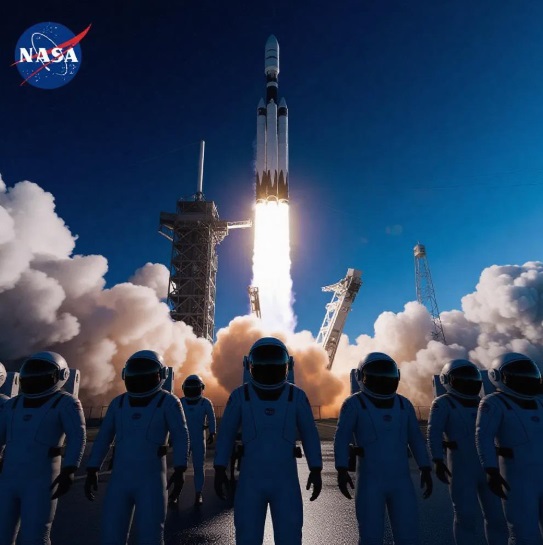
Revolutionizing Space Science
NASA is poised to launch its first-ever rideshare mission through the Science Mission Directorate (SMD), heralding a new era in space exploration. As two groundbreaking projects—**SPHEREx** and **PUNCH**—prepare to take flight aboard a **SpaceX Falcon 9** rocket, the world watches with bated breath. Scheduled to lift off from **Vandenberg Space Force Base** at 8:10 p.m. PDT on March 10, 2025, this mission combines two significant scientific endeavors, merging advanced technology with astronomical inquiry.
A Leap Forward in Science
During a recent press conference, Mark Clampin, acting deputy associate administrator for SMD, shared insights on the significance of this launch strategy. “We call this a rideshare, and it’s a new strategy that SMD is working on to maximize efficiency,” he emphasized. The dual payload approach allows NASA to amplify its scientific output while optimizing resources, truly a game-changer in the field of space science.
The Power of SPHEREx
At the heart of this mission is the **Spectro-Photometer for the History of the Universe, Epoch of Reionization and Ices Explorer (SPHEREx)**. This mission aims to unravel the enigma of the universe’s origins by charting over **400 million galaxies** across cosmic time. With a mission cost of approximately **$488 million**, SPHEREx will conduct a comprehensive all-sky survey in near-infrared light, utilizing **102 different color bands** to maximize data collection.
SPHEREx’s journey begins approximately 42 minutes post-launch, aiming to establish its signal during three key opportunities across the globe—from Antarctica to Svalbard and Fairbanks, Alaska. Such precise planning illustrates the meticulous nature of astrophysical research and the importance of real-time data acquisition in space missions.
The Intricacies of Launch Preparations
The road to uplift has been intricate for this launch, marked by numerous challenges and delays. Denton Gibson, the launch director, acknowledged the hurdles faced in the preparatory phases leading up to this momentous event. Delays were caused by integration issues within the spacecraft’s environmental control system and pneumatic separation system of the payload fairings.
The engineers discovered an **impedance mismatch assembly** issue, which necessitated comprehensive troubleshooting. “We had to pause, understand the issue, and ensure we had a safe path to fly,” Julianna Scheiman, director of NASA Science Missions for SpaceX, explained.
Even weather conditions played a role, as transportation of the encapsulated payload faced setbacks due to high winds. The collective efforts of teams across NASA, SpaceX, and the U.S. Space Force underscore the collaborative spirit essential in overcoming barriers in the high-stakes domain of space exploration.
PUNCH: Understanding Solar Winds
Alongside SPHEREx, the **Polarimeter to Unify the Corona and Heliosphere (PUNCH)** mission will deploy four spacecraft that explore intricate solar phenomena. With a mission budget of **$150 million**, PUNCH aims to observe solar winds that influence both space and terrestrial weather patterns. By measuring these solar outputs, PUNCH’s data will be invaluable in enhancing space weather forecasts, protecting nascent technology and human life in orbit.
The connection between these solar observations and daily life on Earth is profound. For instance, improved predictions regarding solar flares and coronal mass ejections may safeguard satellites and electrical grids, instilling a preventative approach in managing potential cosmic dangers.
The Falcon 9: A Launch Powerhouse
The Falcon 9 rocket, which will facilitate these groundbreaking missions, has a storied history of achievement in its design and operation. The first stage booster set to launch SPHEREx and PUNCH, tail number **B1088**, will be making its third flight, demonstrating the reliability and reuse capabilities of SpaceX’s technology. Following liftoff, B1088 aims to land back at **Landing Zone 4**, marking a successful recovery that continues to bolster SpaceX’s lead in multi-use rocket missions.
The overall launch process exemplifies meticulous engineering and operational protocol, where each phase contributes to the broader objective of advancing human understanding of the universe. The planning and execution of the mission have been refined over numerous previous launches, culminating in this unparalleled collaboration between NASA and SpaceX.
A Future of Rideshare Missions
This is only the beginning for NASA’s rideshare undertakings. As the preparations for SPHEREx and PUNCH progress, discussions are already underway for upcoming missions such as the **Interstellar Mapping and Acceleration Probe (IMAP)** and the **Tandem Reconnection and Cusp Electrodynamics Reconnaissance Satellites (TRACERS)**, both set for anticipated rideshare missions later this year. The potential for increased scientific output through collaborative missions marks an exciting shift in how space agencies will approach future explorations, hinting at a more interconnected and expansive view of our universe.
The sense of excitement around this dual mission is palpable within the scientific community, reflecting the essence of exploration and discovery that characterizes humanity’s quest to understand the cosmos. With SPHEREx and PUNCH, we are on the brink of discovering untold truths about the universe’s history and the dynamic forces at play within our solar system, representing promising advancements in space science that will reverberate for years to come.
To learn about the disclaimer of liability for the content of this website, click here



